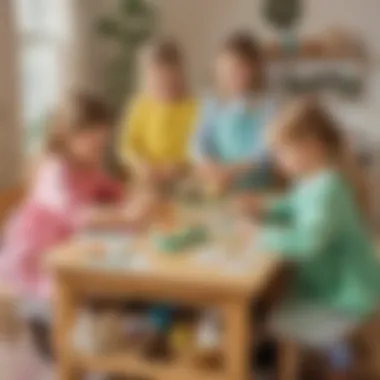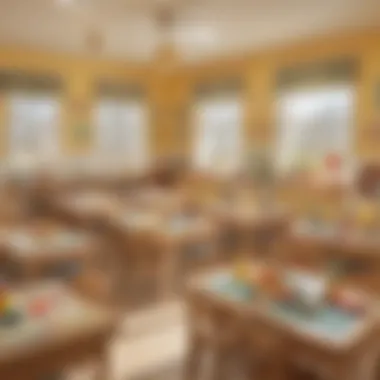Engaging Easter Lessons for Kindergarteners


Intro
Easter is not just about colorful eggs and bunnies; it's steeped in history and culture that spark curiosity in young minds. For kindergarteners, this festive time offers a unique platform for exploration and learning. Understanding Easter can provide kids with valuable lessons about various traditions, festive celebrations, and the joy of giving. With a pinch of creativity and a dash of engagement, educators and caregivers can transform simple Easter concepts into enthralling educational experiences.
As we venture through this guide, we'll uncover diverse themes, craft activities, and lessons tailored to help children grasp Easter’s significance. It’s all about making learning fun while fostering an appreciation for cultural perspectives. Buckle up, because we are about to embark on a delightful journey into Easter!
Understanding Easter
Understanding Easter is more than just an exploration of its traditions and practices; it is about grasping the wider cultural significance this celebration has across various communities. For kindergarteners, uncovering the meaning of Easter provides an opportunity for them to learn about diversity, empathy, and the rich tapestry of human experiences. Educators and caregivers play a vital role in guiding young minds through this journey, where curiosity is the compass.
Easter is often associated with springtime, renewal, and hope. By learning about Easter, children learn where the holiday fits within the season and its broader meanings, which can include themes of rebirth and joy. Here, they can engage with the concepts of sharing and celebration, two key elements in building social awareness.
Through exploration, children not only broaden their knowledge but also develop critical thinking skills. They can ask relevant questions about why different cultures celebrate in their unique ways. This fosters an environment where respect for differences becomes part of their learning. Thus, the section about Easter provides an excellent platform for discussions about inclusivity and understanding.
What is Easter?
Easter is a holiday celebrated primarily by Christians, marking the resurrection of Jesus Christ from the dead. This event symbolizes hope and renewal within the Christian faith, making it a significant occasion for many believers. However, Easter has also evolved to encompass various cultural elements, becoming more than just a religious observance.
In many cultures, Easter includes traditions like colorful eggs, bunny rabbits, and festive meals. These symbols have been adapted into secular celebrations as well, appealing to a broader audience. Ultimately, understanding what Easter represents requires recognizing both its religious roots and wider cultural relevance.
Historical Context of Easter Celebrations
The history of Easter stretches back to significant Christian events, primarily rooted in the New Testament. The first Easter celebration occurred shortly after the resurrection of Jesus, gradually leading to fixed dates and widespread observance. Over the centuries, customs evolved throughout Europe and beyond, influenced by regional practices and local mythology.
At its core, Easter connects to the Jewish Passover. Many elements of the holiday intertwine, highlighting themes of liberation and freedom. This cultural intersection provides a fascinating context for children, opening doors to discussions about interconnectedness.
Cultural Traditions Around the World
Both religious and secular traditions make up Easter celebrations worldwide. Here are some examples:
- In the United States: Easter is known for its egg hunts, where children search for hidden candy-filled eggs, often organized by local communities or families.
- In Spain: Large processions occur, complete with participants dressed in traditional attire, reflecting the holiday's strong historical and religious ties.
- In Italy: Easter is celebrated with a special feast, featuring traditional foods such as lamb and pastries decorated with eggs.
- In Australia: Instead of the Easter Bunny, children may learn about the Easter Bilby, a native marsupial that symbolizes conservation efforts.
Through these diverse practices, children gain an appreciation for global perspectives. Understanding Easter can become a springboard for discussions about how different cultures express their beliefs and traditions, fostering a nurturing ground for diversity in thought and practice.
Easter Symbols
Easter celebration is rich with various symbols, each carrying its own significance and history. These symbols serve more than just aesthetic purposes; they are teaching tools that help educate kindergarteners about Easter's deeper meanings. Incorporating these symbols into lessons can foster curiosity and understanding among children. For instance, recognizing how each symbol relates to themes of renewal, hope, and community can enhance a child's comprehension of Easter.
Common Easter Symbols
When you think of Easter, colorful eggs, fluffy bunnies, and blooming flowers come to mind, right? These common symbols are not just for decoration; they represent important ideas.
- Easter Eggs: These are more than tasty treats. They symbolize new life and resurrection. Kids often find joy in decorating eggs, making it a fun craft activity.
- The Easter Bunny: Known for delivering eggs, this friendly rabbit represents spring and fertility. It connects to the idea of life returning after a long winter.
- Lilies: These flowers bloom in spring and symbolize purity and new beginnings. They can be used in various crafts, adding a natural element to lessons.
Meaning Behind Easter Eggs
Easter eggs have a special story. For many, they are a symbol of rebirth. During Lent, eggs were often forbidden as food, so people would decorate and save them. When Easter came, they celebrated by eating them.
- Decorating eggs can be a great hands-on activity. Encourage children to express their creativity. Let them explore colors, patterns, and even stories through their designs. This helps them engage not just with art but also with the history behind the egg itself.
- Also, you could discuss different egg colors and how they relate to various cultures. For instance, red eggs signify the blood of Christ in some traditions.
The Significance of the Easter Bunny


The Easter Bunny is a figure that sparks joy in many children. But where does this hopping hero come from? The origins are a mix of folklore and cultural traditions. Some say it started in Germany, where the rabbit would lay eggs.
- Fertility Symbol: Rabbits have long been associated with fertility due to their high reproduction rate. This makes them fitting as a symbol for spring and new life.
- Engagement with Tradition: Kids can partake in games and stories featuring the Easter Bunny, which can help them connect with cultural traditions. Engaging with these stories invites discussion about generosity and sharing.
"Symbols are markers of shared meaning; through them, we weave the threads of Easter's rich tapestry into the hearts of our children."
Utilizing these Easter symbols makes learning dynamic. By weaving in stories, crafts, and lessons about their meanings, caregivers and educators can create an immersive educational experience.
Integrating Learning Activities
Integrating various learning activities into the exploration of Easter is essential for young learners. This approach not only makes the learning process engaging but also cultivates a more profound understanding of cultural practices. By incorporating educational elements such as crafting, storytelling, and hands-on science experiments, educators can create a well-rounded educational experience that resonates with kindergarteners' natural curiosity. By mixing activities, children can grasp complex ideas related to Easter while enjoying themselves, thus reinforcing their knowledge in a fun and interactive manner.
Crafting Projects for Easter
Creating Easter Cards
Creating Easter cards is a delightful way for kindergarteners to engage their creativity and express their understanding of the holiday. This craft requires basic materials like colored paper, scissors, and markers, making it an easily accessible project for young children. The joy of making personalized cards can be a beneficial choice as it fosters fine motor skills and encourages children to think about the messages they want to convey, reflecting the values of the holiday, like love and friendship.
An unique aspect of making Easter cards is the opportunity for children to use their imagination, allowing them to design and decorate as they see fit. However, one consideration is the potential for mess; handling glue and scissors can sometimes lead to clutter. Yet, the learning benefits far surpass the minor inconveniences.
Decorating Easter Eggs
Decorating Easter eggs offers a hands-on experience that blends art and tradition. Children can use various tools and techniques, such as dye, stickers, or even paint brushes, to create colorful designs. This activity is often seen as a popular choice because it allows children to explore colors and patterns, enhancing their artistic skills and promoting self-expression.
The unique feature of egg decorating lies in its versatility. Kids can experiment with different materials, which can lead to some fascinating outcomes. However, it's important to keep in mind that some decorating methods can be messy or require adult supervision. Hence, planning is essential to ensure a smooth project.
Storytelling and Reading Activities
Books About Easter
Introducing books about Easter can be a meaningful way to provide context and deeper understanding of the holiday. These stories often incorporate themes of renewal and joy, relatable topics for young ones. Choosing such books sparks children’s imaginations while they learn about traditions through engaging narratives.
A key characteristic of selecting books about Easter is their ability to convey complex themes in a simple manner. They can illustrate concepts like kindness, giving, and community, necessary values that resonate during this festive season. Kids learn best when stories are involved, reinforcing their literacy skills while offering an emotional connection to the material. However, be mindful of selecting age-appropriate books to ensure that the content is relatable and comprehensible.
Incorporating Folktales
Incorporating folktales into Easter lessons adds a rich cultural layer to the learning experience. These tales often carry messages relevant to the season and can introduce children to diverse cultural perspectives. Folktales not only entertain but also serve as vehicles for moral lessons, expanding children’s worldview.
The unique feature of folktales lies in their storytelling format, which captures attention and makes learning memorable. They can be used as discussion starters in classrooms, providing ample opportunities for interaction and critical thinking. However, the challenge may arise in adapting these tales appropriately for young audiences to maintain engagement without losing the essence of the story.
Hands-On Learning with Science
Exploring Egg Science
Egg Science combines Easter traditions with fundamental scientific concepts. This activity teaches children about biology and nature using eggs as a medium to observe various properties, like structure and function in real time. Learning about eggs provides a relatable subject for kids, allowing them to engage while exploring their curiosity.
A crucial aspect of exploring egg science is demonstrating hands-on experiments, such as analyzing the floating and sinking properties of different eggs in water. This method brings about tangible learning experiences, yet it may require careful supervision during experiments to ensure safety and comprehension.
The Chemistry of Colorful Eggs
Exploring the chemistry behind coloring eggs is both fascinating and educational. This includes learning about how dyes react with different materials, sparking an interest in basic chemical principles at an early age. Understanding these reactions can captivate a child’s imagination while embedding scientific knowledge in a playful setting.
The unique feature of this activity is its interactive nature, allowing children to see immediate results and participate in the colorful transformation of ordinary eggs. However, it's essential to use non-toxic dyes and materials and guide children through the process, as some aspects of chemistry can be complex for young minds. Engaging them in fun discussions about what happened during the coloring can make the experience even more enriching.


Easter Games and Challenges
Easter is more than just a day for chocolate and colorful eggs; it’s a rich tapestry of traditions that offer numerous learning opportunities for kindergarteners. The incorporation of games and challenges serves as an engaging way to teach young learners the significance of Easter while having fun. These activities promote teamwork, problem-solving skills, and creativity, all while reinforcing the cultural aspects tied to Easter. Through interactive play, children not only gain knowledge but also develop essential social skills. Let's explore some exciting games and challenges designed for the little ones.
Interactive Easter Egg Hunts
One of the most beloved activities during Easter is the egg hunt, which can be adapted for educational purposes. An interactive Easter egg hunt encourages children to search for hidden eggs while incorporating elements of learning. Educators can fill eggs with letters, numbers, or even simple puzzles that they need to solve to earn their treats. This not only reinforces basic skills like counting and letter recognition but offers an adorable twist on the traditional hunt.
Engaging children in physical activities, like egg hunts, enhances their motor skills, making learning both fun and effective.
Moreover, combining storytelling elements into the egg hunt can enhance engagement. For example, each egg can have a different character from an Easter story, encouraging kids to develop their narrative skills as they uncover the tales that lie within each egg.
Educational Puzzles and Quizzes
Another fantastic avenue for engaging kindergarteners on Easter is through educational puzzles and quizzes. These can range from simple word searches centered around Easter vocabulary to matching games that connect symbols to their meanings.
- Word Searches: Great for improving spelling and recognition of Easter-related words.
- Matching Games: Excellent for memory retention, these tools ask kids to pair symbols like bunnies or eggs with their stories or historical significance.
Such activities not only foster critical thinking but also allow for a collaborative environment where children can work in teams to solve puzzles. The cheerful spirit of Easter will fuel their interest, making the learning process seamless and enjoyable.
Creative Play Activities
Role-Playing as Easter Characters
Role-playing as Easter characters is a delightful approach to help kids understand the cultural narratives surrounding Easter. Children can embody characters like the Easter Bunny, various folktale figures or even eggs themselves. Doing so encourages imaginative play, where they can narrate their adventures or re-enact stories they've learned. This nod towards creative storytelling enriches their understanding and opens their minds to diverse interpretations of Easter traditions.
Moreover, role-playing taps into emotional intelligence, as kids learn to empathize with different roles. It’s a splendid activity because it lets children express themselves and engage with peers while discussing themes of kindness and sharing, which are crucial messages during Easter.
Art-based Challenges
Art-based challenges during Easter integrate creativity into learning in a marvelous way. These tasks might involve egg decorating contests or making Easter-themed crafts. Children can use a variety of materials, allowing them to express their individuality and creativity. Art projects are not just fun; they enhance fine motor skills and help in the development of their artistic sensibilities. Moreover, they can earn a sense of accomplishment when seeing their creations displayed.
Such challenges do often encourage collaboration as well. By working in groups, kids learn to share ideas and respect differing perspectives while contributing to a common goal. However, it’s essential to ensure that instructions are clear, as some children may feel overwhelmed in a group if they are not given individual responsibilities.
In summary, Easter games and challenges integrate learning with merriment. They allow children to explore, learn and bond over shared experiences, ensuring that Easter becomes a memorable educational journey.
Easter and Community Involvement
Easter is often celebrated in grand style with family gatherings, egg hunts, and various church activities. However, the impact of community involvement during this time can significantly enrich the experience for kindergarteners. Engaging young learners in community-based celebrations helps them understand the broader context of Easter beyond personal and familial traditions. It provides a rich opportunity to see how different families unite and participate in festivities.
Learning Through Community Celebrations
Community celebrations can serve as a vibrant backdrop for students to learn about the significance of Easter. Events like local Easter festivals or church gatherings give children a chance to witness cultural expressions and practices firsthand. Participating in group activities, such as parades or community service projects, not only deepens their understanding of Easter's meaning but also fosters a sense of belonging.
Through hands-on participation, kids can learn to appreciate diversity within their community. They can see how various cultures adapt Easter celebrations, turning it into a lively learning experience. For instance, in some communities, Easter is linked with spring festivals that symbolize renewal and hope. By observing and interacting with these events, children build a multi-dimensional view of both Easter and community spirit.
Encouraging Acts of Kindness
Integrating acts of kindness into Easter celebrations can leave a lasting impression on young minds. Encouraging children to engage in community service, such as donating Easter baskets to families in need, teaches them the importance of empathy and helping others. Simple initiatives, like organizing a food drive or creating cards for nursing homes, allow kids to contribute positively in their communities.
When children see the fruits of their kindness, it reinforces the idea that they can make a difference. These experiences help nurture a sense of responsibility and compassion. They learn that Easter is not just a time for receiving but for giving as well. These acts foster a culture of care and mutual support among peers and adults alike, ensuring that the spirit of Easter extends beyond individual families.


Connecting with Local Traditions
Children feel a stronger connection to their community when they learn and participate in local traditions surrounding Easter. Each festive event or ceremony carries unique cultural expressions that have been passed down through generations. In some regions, for example, special rituals may involve singing around a bonfire or sharing traditional foods. Learning about these customs can create a sense of pride in their heritage and encourage curiosity about different cultures.
Engaging children in local Easter traditions can involve storytelling sessions, where they are introduced to legends explaining the history of Easter celebrations. Children can also have the opportunity to take part in typical local games or crafts that reflect the community's practices. Such experiences drive home the importance of heritage and belonging, reinforcing their identity within their environment.
"Community involvement fosters a sense of belonging and teaches young learners the true spirit of Easter through empathy, kindness, and connection with local traditions."
Through community events, encouraging kindness, and an appreciation for local traditions, education on Easter takes a more expansive form. It builds not only knowledge about the holiday itself but also instills vital social values, making the learning experience rich and meaningful for kindergarteners.
Safety and Inclusivity in Easter Celebrations
In the context of Easter, safety and inclusivity become paramount in creating a learning environment where every child feels valued and protected. This section will delve into these themes, emphasizing their significance for educators and caregivers alike.
Celebrating with Diverse Perspectives
When planning Easter activities, it's essential to recognize the rich tapestry of traditions that children bring from their families. Each kid might hold a story or custom that adds depth to the celebration. For instance, some families may focus on the religious aspects, while others might lean more towards secular habits like egg hunts or themed games. Recognizing these diverse perspectives aids in creating a richer educational experience.
Children can benefit from sharing their own home traditions, leading to discussions that enhance cultural awareness. For example, if a child mentions a family gathering that involves cooking special dishes for Easter, it opens up avenues to talk about various food traditions across cultures.
Ensuring Safety During Activities
Easter festivities can be a whirlwind of excitement, but safety should never take a backseat. Ensuring that all activities are conducted in a secure setting allows everyone to enjoy the learning process without concern. Here are key considerations:
- Supervised Activities: Always keep an eye on children during activities, especially during outdoor egg hunts. Clear boundaries must be established.
- Allergy Awareness: Be mindful of any allergies that children might have, particularly concerning food items related with the celebration. Always have alternative snacks available.
- Navigating Equipment: When using crafting materials or games with equipment, like those inflatable bounce houses or small toys, check them regularly.
By being proactive in these areas, caregivers can foster a safe environment where children can engage freely.
Creating an Inclusive Environment
An inclusive environment allows every child to participate fully, regardless of their background or abilities. This can be achieved in various ways. Consider incorporating these ideas into your Easter celebrations:
- Adaptive Activities: Modify games and crafts to suit children with different physical abilities. For example, if some kids have mobility challenges, they can engage in accessible egg decorating or storytelling activities.
- Language Considerations: In classrooms or gatherings that include multilingual students, use simple language and visual aids. Incorporating various languages in your educational material can also bolster understanding and respect.
- Celebration of Differences: Discussing various cultural traditions tied to Easter openly lets children see the beauty in diversity. This can be a simple show-and-tell or a collaborative art project showcasing different customs.
"Teaching children about diversity strengthens their social skills and emotional intelligence, allowing them to navigate a multicultural world with empathy."
Creating a safe and inclusive atmosphere during Easter celebrations is not just about minimizing risks or ensuring everyone can join in; it's about weaving together a community where all children can feel they belong. In doing so, learning becomes not just an educational task but a deeply enriching experience that shapes their understanding of the world. Engaging with safety and inclusivity creates a right foundation for little learners, nurturing their emotional and social growth.
Each step taken towards ensuring both safety and inclusivity reinforces our commitment to providing a comprehensive educational experience during this vibrant holiday.
Finale
The Conclusion of this article serves as an important synthesis of all the educational strategies and ideas discussed regarding Easter. It's not just a wrap-up; it encapsulates the essence of fostering curiosity and engagement among kindergarteners through a multifaceted approach. By exploring the various ways to teach young learners about Easter, we emphasize both the cultural significance of the holiday and the myriad of activities available to spark their interest.
Recap of Educational Approaches
Throughout this article, we discussed several educational approaches suitable for teaching kindergarteners about Easter. Engaging crafting projects allow children to express their creativity while instilling the holiday's meaning. For instance, decorating eggs or making festive cards can become tangible expressions of their learning.
Storytelling and reading activities stand out as vital tools—by choosing age-appropriate books about Easter, children can understand the holiday's background and its significance in a delightful way. Incorporating folktales that are enriched with cultural traditions makes the learning process enjoyable and expands their understanding.
Hands-on learning with science presents yet another effective method. Kids can explore concepts such as the science behind eggshells or how to color eggs through simple chemistry experiments. These activities not only teach scientific principles but also keep the children engaged with practical, fun experiments.
"Learning should be a playful journey, merging information with creativity."
Future Learning Opportunities
Looking ahead, there are countless learning opportunities waiting to be unlocked beyond the confines of Easter celebrations. Future lessons can evolve around environmental themes that relate to spring, such as planting seeds or discussing the life cycles of animals. These can intertwine a love for nature with understanding Easter's themes of rebirth and renewal.
Furthermore, educators and parents can use this festive time to kickstart themes of kindness and community service, tying them to the spirit of Easter. Organizing charity events like food drives or creating cards for those in nursing homes helps kids learn about empathy and generosity in real, impactful ways.
Integrating technology, like apps that explore traditions around the world, can also bring an exciting twist to future lessons. These resources can act as windows into different cultures and deepen respect for diversity, something crucial in today’s interconnected world.
In summary, concluding our exploration of Easter highlights that education is not merely about imparting knowledge; it’s about igniting a passion for discovery that can flourish long after the holiday has passed. With thoughtful approaches, we can make sure kindergarteners carry forward the important lessons learned during this special time.







